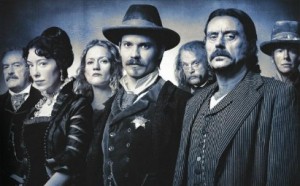 A piece titled “Deadwood as History” by Anne Hyde in Foreign Affairs on the historical content (or lack thereof) of HBO’s Deadwood begins: “All Westerns are stories of people attempting to impose order on a chaotic, lawless, and savage environment.” In other words, all Westerns are stories about “frontiers.” The space of the frontier—its social relations, imaginaries, and material qualities—is what gives Westerns (and Deadwood) such dynamic plotlines and what makes them perhaps the consummate geographical genre. Frontiers are about insides and outsides, civilization and barbarism, statehood and the law; they are about the messiness and violence of property relations. Frontiers are based on distinct ideas of race and nature, and they are always constituted in relation to other places materially and symbolically. The richness of “frontier” as a spatial and historical concept is what makes it such a productive conceptual and critical tool in my research; it’s also what makes Deadwood fun to watch.
A piece titled “Deadwood as History” by Anne Hyde in Foreign Affairs on the historical content (or lack thereof) of HBO’s Deadwood begins: “All Westerns are stories of people attempting to impose order on a chaotic, lawless, and savage environment.” In other words, all Westerns are stories about “frontiers.” The space of the frontier—its social relations, imaginaries, and material qualities—is what gives Westerns (and Deadwood) such dynamic plotlines and what makes them perhaps the consummate geographical genre. Frontiers are about insides and outsides, civilization and barbarism, statehood and the law; they are about the messiness and violence of property relations. Frontiers are based on distinct ideas of race and nature, and they are always constituted in relation to other places materially and symbolically. The richness of “frontier” as a spatial and historical concept is what makes it such a productive conceptual and critical tool in my research; it’s also what makes Deadwood fun to watch.
I work in a country (Colombia) that could be said to have multiple frontiers. My research is focused mainly in the northwest region called Urabá—an area I analyze as a frontier zone. I don’t mean “frontier” in any primal (mythical) sense with its associated romantic ideas of uninhabited pristine wilderness and unsoiled democratic proclivities à la Frederick Turner. Nor do I conceive of frontiers as delineating the start of untouched preserves beyond the reach of global capitalist development. (Despite being cast as peripheral even within its own national context, Urabá is deeply rooted in the Black Atlantic and the making of the modern world.)
Drawing on the work of Colombian anthropologist Margarita Serje, my use of frontier is precisely aimed at critically conjuring the spatial production of places like Urabá in Colombia’s historical geopolitical imaginaries as “stateless” and “savage” zones of irreconcilable alterity.* Frontiers obviously have a strong colonial lineage, meaning that even today they are portrayed as stateless, violent, and ungoverned zones packed with untold natural wealth and exuberance—a dystopian Eden—populated (if at all) by people or groups deemed by dominant cultures as somehow problematic. The frontier is an imaginary.
The frontier also has a materiality. As Deadwood and Urabá make clear, the ideological dimensions of the frontier are mutually wrapped up with how these are also spaces where the social relations of property are acutely contested and in flux—usually, violently—meaning that iterative proceesses of primitive accumulation are woven into the very fabric of social and political struggles in such regions. Resource frontiers constitute emergent horizons of accumulation and destruction. In Urabá this corresponds to drug-trafficking paramilitaries and their allied agribusinesses preying on Afro-Colombian peasants, in Deadwood to gold miners encroaching on tribal lands in the Black Hills.
As liminal places subject to unique forms of regulation, which on the ground looks a whole lot like un-regulation, capitalist relations take on especially violent dynamics in these spaces. As Tsing describes, “Frontiers are unregulated because they arise in the interstitial places made by collaborations among legitimate and illegitimate partners: armies and bandits; gangsters and corporations; builders and despoilers. They confuse the boundaries of law and theft, governance and violence, use and destruction” (2005:27).
Hyde’s article on Deadwood presents a tension that seems inherent to the notion of the frontier itself: the absence and presence of the state or at least a state that’s too weak to really take control. For instance, she argues:
To its credit, Deadwood avoids one of the worst offenses of the Western genre. Most Westerns misleadingly present the natural state of the frontier as chaos, a disorder that existed until American law, ethics, and above all, capital rendered it orderly…. In the Dakotas and scores of other places in the U.S. West, the root of the trouble was not a Hobbesian state of nature but rather the encroachment of the state, or at least its weak nineteenth-century form.
Indeed, narratives of statelessness are a key component of frontier discourses. She laments how, despite its best efforts, the U.S. government was too weak to prevent miners from encroaching on the Black Hills. Another interpretation would be that the government turned a blind eye and used the gold-hungry miners as a frontier proxy force for dispossession and colonization. My point is that these discourses of state absence or weakness are often the very condition that makes possible all sorts of maneuvers backed by powerful actors—mining companies, drug traffickers, land speculators—in which on closer inspection the state isn’t really all that absent.
In Colombia, similarly, people often claim the root of the problem afflicting places such as Urabá is the historical and ongoing “absence of the state.” Paramilitary commanders explicitly couch their violent activities as the “creation of a state in its absence,” while local residents regularly lament their “abandonment” by the state. It’s almost like the fiction of the frontier helps propagate an even more elaborate fiction—that of the state itself.
* Serje, Margarita. 2005. El revés de la nación: Territorios salvajes, fronteras y tierras de nadie. Bogotá: Ediciones Universidad de Los Andes.
